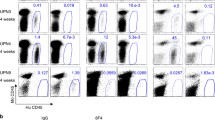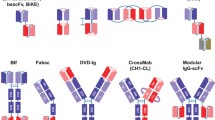Abstract
IREM-1 is an inhibitory cell surface receptor with an unknown function and is expressed on myeloid cell lineages, including cell lines derived from acute myeloid leukemia (AML) patients. We have generated a series of monoclonal antibodies (mAbs) against the extracellular domain of IREM-1 and further assessed its expression in normal and AML cells. IREM-1 was restricted to cells from myeloid origin and extensive expression analysis in primary cells obtained from AML patients showed IREM-1 expression in leukemic blasts of 72% (39/54) of samples. We therefore searched for specific IREM-1 mAbs with activity in functional complement-dependent cytotoxicity (CDC) and antibody-dependent cellular cytotoxicity (ADCC). Lead mAbs against IREM-1 showed specific cytotoxic activity against a variety of AML-derived cell lines and freshly isolated blasts from AML patients. Internalization of mAbs upon IREM-1 binding was also shown. In vivo anticancer activity of lead mAbs was observed in an established HL-60 xenograft model with a tumor growth delay of up to 40% and in a model using primary human AML cells, where treatment with anti-IREM-1 mAb resulted in a significant reduction of engrafted human cells. These results demonstrate IREM-1 as a potential novel target for immunotherapy of AML.







Similar content being viewed by others
References
Ravandi F, Burnett AK, Agura ED, Kantarjian HM . Progress in the treatment of acute myeloid leukemia. Cancer 2007; 110: 1900–1910.
Doepfner KT, Boller D, Arcaro A . Targeting receptor tyrosine kinase signaling in acute myeloid leukemia. Crit Rev Oncol Hematol 2007; 63: 215–230.
Pratz K, Levis M . Incorporating FLT3 inhibitors into acute myeloid leukemia treatment regimens. Leuk Lymphoma 2008; 49: 852–863.
Giles F, Estey E, O′Brien S . Gemtuzumab ozogamicin in the treatment of acute myeloid leukemia. Cancer 2003; 98: 2095–2104.
Tsimberidou AM, Giles FJ, Estey E, O′Brien S, Keating MJ, Kantarjian HM . The role of gemtuzumab ozogamicin in acute leukaemia therapy. Br J Haematol 2006; 132: 398–409.
Alvarez-Errico D, Aguilar H, Kitzig F, Brckalo T, Sayos J, Lopez-Botet M . IREM-1 is a novel inhibitory receptor expressed by myeloid cells. Eur J Immunol 2004; 34: 3690–3701.
Sui L, Li N, Liu Q, Zhang W, Wan T, Wang B et al. IgSF13, a novel human inhibitory receptor of the immunoglobulin superfamily, is preferentially expressed in dendritic cells and monocytes. Biochem Biophys Res Commun 2004; 319: 920–928.
Marquez JA, Galfre E, Dupeux F, Flot D, Moran O, Dimasi N . The crystal structure of the extracellular domain of the inhibitor receptor expressed on myeloid cells IREM-1. J Mol Biol 2007; 367: 310–318.
Alvarez-Errico D, Sayos J, Lopez-Botet M . The IREM-1 (CD300f) inhibitory receptor associates with the p85alpha subunit of phosphoinositide 3-kinase. J Immunol 2007; 178: 808–816.
Vitale C, Romagnani C, Puccetti A, Olive D, Costello R, Chiossone L et al. Surface expression and function of p75/AIRM-1 or CD33 in acute myeloid leukemias: engagement of CD33 induces apoptosis of leukemic cells. Proc Natl Acad Sci USA 2001; 98: 5764–5769.
Jordan CT . The leukemic stem cell. Best Pract Res Clin Haematol 2007; 20: 13–18.
Caron PC, Co MS, Bull MK, Avdalovic NM, Queen C, Scheinberg DA . Biological and immunological features of humanized M195 (anti-CD33) monoclonal antibodies. Cancer Res 1992; 52: 6761–6767.
Jilani I, Estey E, Huh Y, Joe Y, Manshouri T, Yared M et al. Differences in CD33 intensity between various myeloid neoplasms. Am J Clin Pathol 2002; 118: 560–566.
Bakker AB, van den Oudenrijn S, Bakker AQ, Feller N, van Meijer M, Bia JA et al. C-type lectin-like molecule-1: a novel myeloid cell surface marker associated with acute myeloid leukemia. Cancer Res 2004; 64: 8443–8450.
Legrand O, Perrot JY, Baudard M, Cordier A, Lautier R, Simonin G et al. The immunophenotype of 177 adults with acute myeloid leukemia: proposal of a prognostic score. Blood 2000; 96: 870–877.
Kossman SE, Scheinberg DA, Jurcic JG, Jimenez J, Caron PC . A phase I trial of humanized monoclonal antibody HuM195 (anti-CD33) with low-dose interleukin 2 in acute myelogenous leukemia. Clin Cancer Res 1999; 5: 2748–2755.
Jurcic J . Ab therapy of AML: native anti-CD33 Ab and drug conjugates. Cytotherapy 2007; 10: 7–12.
Voisin T, El Firar A, Rouyer-Fessard C, Gratio V, Laburthe M . A hallmark of immunoreceptor, the tyrosine-based inhibitory motif ITIM, is present in the G protein-coupled receptor OX1R for orexins and drives apoptosis: a novel mechanism. Faseb J 2008; 22: 1993–2002.
Can I, Tahara-Hanaoka S, Hitomi K, Nakano T, Nakahashi-Oda C, Kurita N et al. Caspase-independent cell death by CD300LF (MAIR-V), an inhibitory immunoglobulin-like receptor on myeloid cells. J Immunol 2008; 180: 207–213.
Walter RB, Raden BW, Kamikura DM, Cooper JA, Bernstein ID . Influence of CD33 expression levels and ITIM-dependent internalization on gemtuzumab ozogamicin-induced cytotoxicity. Blood 2005; 105: 1295–1302.
Wu H, Windmiller DA, Wang L, Backer JM . YXXM motifs in the PDGF-beta receptor serve dual roles as phosphoinositide 3-kinase binding motifs and tyrosine-based endocytic sorting signals. J Biol Chem 2003; 278: 40425–40428.
Kohler G, Milstein C . Continuous cultures of fused cells secreting antibody of predefined specificity. Nature 1975; 256: 495–497.
Ausubel FM, Brent R, Kingston RE, Moore DD, Seidman JG, Smith JA et al. Current Protocols in Molecular Biology. John Wiley & Sons, 2005.
Robinson JP, Darzynkiewicz Z, Dobrucki J, Hyun W, Nolan J, Orfao A et al. Current Protocols in Cytometry. John Wiley & Sons, 2006.
Canziani GA, Klakamp S, Myszka DG . Kinetic screening of antibodies from crude hybridoma samples using Biacore. Anal Biochem 2004; 325: 301–307.
Bonifacino JS, Dasso M, Harford JB, Lippincott-Schwartz J, Yamada KM . Current Protocols in Cell Biology. John Wiley & Sons, 2003.
Korver W, Singh S, Liu S, Zhao X, Yonkovich S, Sweeney A et al. The lymphoid cell surface receptor NTB-A: a novel monoclonal antibody target for leukaemia and lymphoma therapeutics. Br J Haematol 2007; 137: 307–318.
Coleman EJ, Brooks KJ, Smallshaw JE, Vitetta ES . The Fc portion of UV3, an anti-CD54 monoclonal antibody, is critical for its antitumor activity in SCID mice with human multiple myeloma or lymphoma cell lines. J Immunother 2006; 29: 489–498.
Naumovski L, Ramos J, Sirisawad M, Chen J, Thiemann P, Lecane P et al. Sapphyrins induce apoptosis in hematopoietic tumor-derived cell lines and show in vivo antitumor activity. Mol Cancer Ther 2005; 4: 968–976.
Walter RB, Boyle KM, Appelbaum FR, Bernstein ID, Pagel JM . Simultaneously targeting CD45 significantly increases cytotoxicity of the anti-CD33 immunoconjugate, gemtuzumab ozogamicin, against acute myeloid leukemia (AML) cells and improves survival of mice bearing human AML xenografts. Blood 2008; 111: 4813–4816.
Acknowledgements
WK, XZ, SS, CP, JZ, MLG, SS, SY, SL, XZ, NT, CZ and DG performed experiments; WK, XZ, MLG, CTJ, JG, EDH and AA designed the studies, wrote and critically revised the manuscript.
Author information
Authors and Affiliations
Corresponding author
Additional information
Supplementary Information accompanies the paper on the Leukemia website (http://www.nature.com/leu)
Supplementary information
Rights and permissions
About this article
Cite this article
Korver, W., Zhao, X., Singh, S. et al. Monoclonal antibodies against IREM-1: potential for targeted therapy of AML. Leukemia 23, 1587–1597 (2009). https://doi.org/10.1038/leu.2009.99
Received:
Revised:
Accepted:
Published:
Issue Date:
DOI: https://doi.org/10.1038/leu.2009.99
- Springer Nature Limited
Keywords
This article is cited by
-
The role of phosphatidylserine recognition receptors in multiple biological functions
Cellular & Molecular Biology Letters (2020)
-
Acute myeloid leukemia targets for bispecific antibodies
Blood Cancer Journal (2017)
-
Leukemia stem cells
Annals of Hematology (2011)




